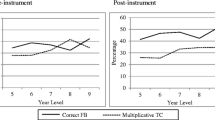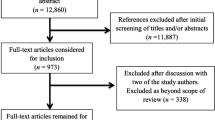Abstract
In this qualitative study, we investigated teachers’ use of proportional knowledge resources while being asked to appropriately identify if a given situation was proportional or not using clinical interview data from a large grant funded project. We found that knowledge resources related to the mathematical structure of the situation were most useful in correctly identifying the situation. Interestingly, teachers were often able to identify a mathematical expression for the situations; however, these rules did not support the correct identification of the situation as proportional or not. We discuss suggested knowledge resources for the creation of a coordination class for identifying situations that are proportional from those that are not as well as implications for teacher education and professional development around proportional reasoning.


Similar content being viewed by others
References
Akar, G. (2010). Different levels of reasoning in within state ratio conception and the conceptualization of rate: A possible example. In P. Brosnan, D. B. Erchick, & L. Flevares (Eds.), Proceedings of the 32nd annual meeting of the North American Chapter of the International Group for the Psychology of Mathematics Education (Vol. 4, pp. 711–719). Columbus: The University of Ohio.
Arican, M. (2018). Preservice mathematics teachers’ understanding of and abilities to differentiate proportional relationships from nonproportional relationships. International Journal of Science and Mathematics Education. https://doi.org/10.1007/s10763-018-9931-x.
Beckmann, S., & Izsák, A. (2015). Two perspectives on proportional relationships: Extending complementary origins of multiplication in terms of quantities. Journal for Research in Mathematics Education, 46(1), 17–38. https://doi.org/10.5951/jresematheduc.46.1.0017.
Davis, J. D. (2016). Middle school mathematics teachers’ proportional reasoning mathematical knowledge for teaching: Strengths, weaknesses, and influencing factors. Presented in J. M. Choppin (chair), Middle school mathematics teachers’ Common Core State Standards for Mathematics interpretations and enactments: Complementary findings from multiple instruments. Symposium presented at the Annual Meeting of the American Educational Research Association, Washington, DC.
de Bock, D., Van Dooren, W., Janssens, D., & Verschaffel, L. (2002). Improper use of linear reasoning: An in-depth study of the nature and the irresistibility of secondary school students' errors. Educational Studies in Mathematics, 50(3), 311–334.
diSessa, A. A. (1988). Knowledge in pieces. In G. Forman & P. Pufall (Eds.), Constructivism in the computer age (pp. 49–70). Hillsdale: Lawrence Erlbaum Associates, Inc.
diSessa, A. A. (2006). A history of conceptual change research: Threads and fault lines. In R. K. Sawyer (Ed.), The Cambridge handbook of the learning sciences (pp. 265–282). New York: Cambridge University Press.
diSessa, A. A., & Sherin, B. L. (1998). What changes in conceptual change. International Journal of Science Education, 20(10), 1155–1191.
diSessa, A. A., Sherin, B. L., & Levin, M. (2016). Knowledge analysis: An introduction. In A. A. diSessa, M. Levin, & N. J. S. Brown (Eds.), Knowledge and interaction: A synthetic agenda for the learning sciences (pp. 30–71). New York: Routledge.
Erlwanger, S. H. (1973). Benny's conception of rules and answers in IPI mathematics. Journal of Children's Mathematical Behavior, 1(2), 7–26.
Greer, B. (2010). Overview of papers: Why is linear thinking so dominant? Mathematical Thinking and Learning, 12(1), 109–115.
Hammer, D. (2000). Student resources for learning introductory physics. American Journal of Physics, Physics Education Research Supplement, 68(S1), S52–S59.
Harel, G., & Behr, M. (1995). Teachers’ solutions for multiplicative problems. Hiroshima Journal of Mathematics Education, 3, 31–51.
Harel, G., Behr, M., Post, T., & Lesh, R. (1992). The blocks task: Comparative analysis of the task with other proportion tasks and qualitative reasoning skills of seventh-grade children in solving the task. Cognition and Instruction, 9(1), 45–06.
Hilton, A., Hilton, G., Dole, S., & Goos, M. (2016). Promoting middle school students’ proportional reasoning skills through an ongoing professional development programme for teachers. Educational Studies in Mathematics, 92(2), 193–219. https://doi.org/10.1007/s10649-016-9694-7.
Izsák, A., & Jacobson, E. (2017). Preservice teachers’ reasoning about relationships that are and are not proportional: A knowledge-in-pieces account. Journal for Research in Mathematics Education, 48(3), 300–339. https://doi.org/10.5951/jresematheduc.48.3.0300.
Lamon, S. (2007). Rational numbers and proportional reasoning: Toward a theoretical framework for research. In F. K. Lester (Ed.), Second handbook of research on mathematics teaching and learning (pp. 629–667). Reston: National Council of Teachers of Mathematics.
Lobato, J., & Ellis, A. (2010). Developing essential understanding of ratios, proportions & proportional reasoning: Grades 6–8. Reston: National Council of Teachers of Mathematics.
Miles, M. B., & Huberman, A. M. (1994). Qualitative data analysis (2nd ed.). Thousand Oaks: Sage.
Modestou, M., & Gagatsis, A. (2007). Students’ improper proportional reasoning: A result of the epistemological obstacle of “linearity”. Educational Psychology, 27(1), 75–92. https://doi.org/10.1080/01443410601061462.
Modestou, M., & Gagatsis, A. (2010). Cognitive and metacognitive aspects of proportional reasoning. Mathematical Thinking and Learning, 12(1), 36–53. https://doi.org/10.1080/10986060903465822.
National Council of Teachers of Mathematics. (2000). Principles and standards for school mathematics. Reston: National Council of Teachers of Mathematics, Inc.
National Governors Association Center for Best Practices [NGA Center], & Council of Chief State School Officers [CCSSO]. (2010). Common core state standards for mathematics. Washington, DC: Authors Retrieved from http://www.corestandards.org/assets/CCSSI_MathStandards.pdf.
NGSS Lead States. (2013). Next generation science standards: For states, by states. Washington, DC: The National Academies Press.
Orrill, C. H., Izsák, A, Cohen, A., Templin, J., & Lobato, J. (2010). Preliminary observations of teachers’ multiplicative reasoning: Insights from Does it Work and Diagnosing Teachers’ Multiplicative Reasoning projects (Technical Report #6). Dartmouth, MA: Kaput Center for Research and Innovation in STEM Education, University of Massachusetts.
Orrill, C. H., Brown, R. E., Nagar, G. G., Millett, J., Park, J., & Burke, J. P. (2017). Extending appropriateness: Further exploration of teachers’ knowledge resources for proportional reasoning. In E. Galindo, & J. Newton (Eds.), Proceedings of the 39th annual meeting of the North American Chapter of the International Group for the Psychology of Mathematics Education (pp. 581–588). Indianapolis, IN: Hoosier Association of Mathematics Teacher Educators
Parnafes, O. (2007). What does “fast” mean? Understanding the physical world through computational representations. Journal of the Learning Sciences, 16(3), 415–450. https://doi.org/10.1080/10508400701413443.
Riley, K. R. (2010). Teachers’ understanding of proportional reasoning. In P. Brosnan, D. B. Erchick, & L. Flevares (Eds.), Proceedings of the 32nd annual meeting of the North American Chapter of the International Group for the Psychology of Mathematics Education (pp. 1055–1061). Columbus: The Ohio State University.
Stavy, R., & Tirosh, D. (2000). How students (mis)-understand science and mathematics: Intuitive rules. New York: Teachers College Press.
Steen, L. (Ed.). (2001). Mathematics and democracy: The case for quantitative literacy. United States: The National Council on Education and the Disciplines.
Van Dooren, W., de Bock, D., Hessels, A., Janssens, D., & Verschaffel, L. (2005). Not everything is proportional: Effects of age and problem type on propensities for overgeneralization. Cognition and Instruction, 23(1), 57–86.
Van Dooren, W., de Bock, D., Janssens, D., & Verschaffel, L. (2008). The linear imperative: An inventory and conceptual analysis of students’ overuse of linearity. Journal for Research in Mathematics Education, 39(3), 311–342.
Vergnaud, G. (1983). Multiplicative structures. In R. Lesh & M. Landau (Eds.), Acquisition of mathematics concepts and processes. New York: Academic Press.
Weiland, T., Orrill, C., Nagar, G., Brown, R.E., & Burke, J. (2019a). A framework for a robust understanding of proportional reasoning for teaching. Manuscript submitted for publication
Weiland, T., Orrill, C., Brown, R., & Nagar, G. (2019b). Mathematics teachers’ ability to identify situations appropriate for proportional reasoning. Research in Mathematics Education. https://doi.org/10.1080/14794802.2019.1579668
Acknowledgments
The authors wish to thank Gili Nagar, James Burke, Jinsook Park, and John Millett for their help on earlier versions of this analysis.
Funding
The work reported here was supported by the National Science Foundation under grant DRL-1054170.
Author information
Authors and Affiliations
Corresponding author
Ethics declarations
Disclaimer
The opinions expressed here are those of the authors and may not reflect those of the NSF.
Rights and permissions
About this article
Cite this article
Brown, R.E., Weiland, T. & Orrill, C.H. Mathematics Teachers’ Use of Knowledge Resources When Identifying Proportional Reasoning Situations. Int J of Sci and Math Educ 18, 1085–1104 (2020). https://doi.org/10.1007/s10763-019-10006-3
Received:
Accepted:
Published:
Issue Date:
DOI: https://doi.org/10.1007/s10763-019-10006-3




